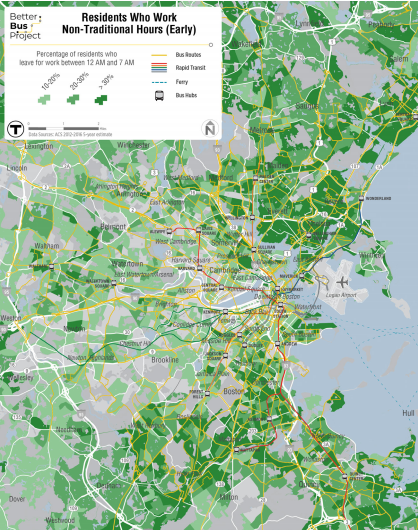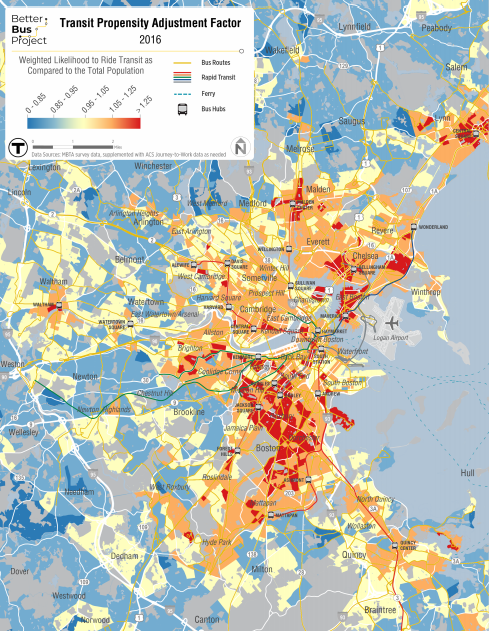That goal leaves low income SL4/SL5 riders with pretty poor options. My wild dream is that Phase 3 could be made to work, maybe not as originally planned, but in such a way that people at Dudley can get a one seat ride to the Seaport/Airport. Specifically Dudley to Logan which is a rather high demand route for airport employees. Going LRV makes that pretty impossible in the next 40 years until idk maybe an F branch to Dudley? :grin:
Since when did Roxbury have an unnaturally high travel orientation to the Seaport and Airport? Sorry...that's a wild reach of magical thinking right there. Thru-and-thru demand was one of the smelliest things about the shotgun marriage of "equal-or-better" Orange Line replacement and Seaport transit when they first came up with it. Then they stopped promoting that utility altogether when the tunnel design started going underwater on schedule performance and everyone was forced into a bus-to-bus transfer at Boylston Under Loop. It became a two-seat trip whether you built Phase III with its loop transfer or built off the Green Line outer tracks with a cross-platform transfer. The powers that be obviously weren't believing their own hype that Dudley-Logan or Dudley-Seaport one-seat was some #1-with-a-bullet travel pattern. And two decades of time passed has not given any additional credence to it in the form of tangible number projections. Logan--BECAUSE of broken links in the neighborhood-to-Downtown transit connections--still retains a workforce that tilts a little heavier to the North Shore than any other single region of the metro area...because there are fewer broken links/transfers on that end of the compass vs. some of the other neighborhoods and innermost 'burbs.
40 years? I fucking hope not, because that means we've failed to connect the Seaport to all the downtown transfers and you can kiss further growth in the CBD goodbye as everything gridlocks. If, in your own words, a do-over of Phase III that actually
works at a buildable price qualifies as the stuff of "wild dreams", then we better be willing to widen the search for a solution rather than getting too-precious about mode choices. As I said, LRV is only the prevailing consideration because the Green Line is the closest thing to hook it into. If some other extant BRT thing were the closest available, then obviously that would be the choice instead. That shouldn't be so hard to understand. Something/anything downtown that's already there with some available orientation to hook it to means interlining is possible in a way Phase III and the forced loop transfer totally belly-flopped on. Kvetching about price is also a useless exercise here; the BRT tunnel
already suicided itself on design-related cost blowouts. If picking back up, it's quite literally impossible to do worse than Phase III did on cost scoring or project timeframe. Anything that attempts to be an undead project by direct-addressing what killed Phase III so very dead will start out in a more favorable place by default.
Other point, a large portion of the Silver Line's funding comes from Massport, and they can and do offer up the big bucks to improve service. They want more capacity to Drydock and Logan and they want it now, as nice as LRV may be for a Focus40 goal, improving BRT can and should happen now.
Completely and utterly irrelevant statement, because tracks aren't going to get laid in the Ted. SL1 will continue as BRT looping at South Station, with Massport funding shares probably being much the same as ever.
Airport travel from downtown was never a problem because the Blue Line has always been there (excepting Red which still lacks the Blue connection, but SL1 plugs that gap).
Seaport travel from downtown is where growth is gridlocking everything. Interlining into the Transitway stops and SL2 with higher-capacity vehicles directly addresses that. SL1 by and large works as intended for the audience it's intended for (unless you've got real math to show for that supposed top-priority Roxbury-Logan demand).
SL1's not the last word on Logan connectivity for everyone. Red-Blue offers up more balance. Hooking Green to Dudley sends those schedules into Gov't Ctr. where hitting Blue serves the same need for those Logan employees from Roxbury. And the Urban Ring NE quadrant--fileted either from downtown thru Lechmere/Sullivan (maybe even interlined with the Seaport) or from Cambridge on the Ring NW quadrant--eventually opens up the third direct option complementing the mix. I expect that particular build to take awhile, but the existence of the UR's northern quadrants as--surprise!!!--an easiest-feasible Green Line tie-in means there isn't some modal game-changer lurking inside an SL1 bus forcing reconsideration of how/where we hook all the other pieces together. Personally liking buses better than trolleys or wondering what decade we're going to wake up and fund something doesn't change what the interfacing mode is for actually getting somewhere through the transfers on the system.






